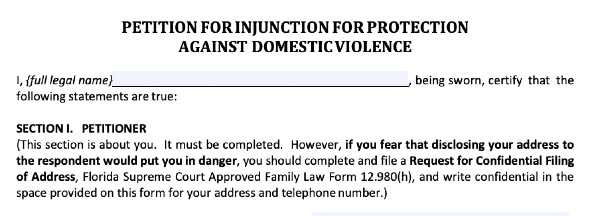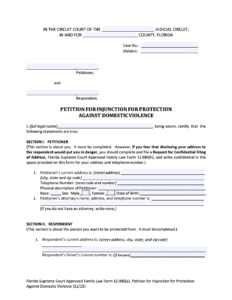Responding to a Domestic Violence Injunction

If you were recently served with a petition for an injunction for protection from domestic violence (sometimes called a restraining order), contact the attorneys at Sammis Law Firm.
For more than fifteen years, our attorneys have been appearing in court in Tampa and Plant City to represent respondents facing false or exaggerated accusations of domestic violence, repeat violence, dating violence, or stalking.
If the allegations of domestic violence resulted in an arrest for domestic violence battery or related charges, then our experienced criminal defense attorneys can represent you on the felony or misdemeanor charges as well.
If a battered woman is being terrorized by her boyfriend or husband, then a temporary injunction is needed. The temporary injunction might help the women escape being injured or even killed by the other person. Unfortunately, not everyone filing a petition is in that situation.
False allegations in petitions are all too common. The petitioner might be motivated to make false allegations in order to gain an unfair advantage in a family law dispute concerning the division of assets, child custody, or child support.
Sometimes, false allegations are motivated by anger or a desire for revenge. You should respond appropriately to protect your rights if the allegations are false or exaggerated.
We fight these cases aggressively. We can request a continuance so that we can take the deposition of the petitioner and require the petitioner to provide us with a copy of any documents that support or disprove the allegations.
The continuance also gives us a chance to subpoena other witnesses to appear in court or bring documents that disprove the allegations.
Don’t face the judge alone. Contact an attorney at Sammis Law Firm to discuss your rights during a domestic violence injunction hearing.
Call 813-250-0500.
What is a Domestic Violence Injunction for Protection?
An injunction is a court order that prevents you from doing something or requires you to undo some wrong or injury. Under Section 741.30(1)(e), F.S., a family member or household member can file an injunction for protection against domestic violence.
The parties do not need to be married if they have previously lived together as a family or have a child in common.
The petition for protection from domestic violence must include a sworn allegation of domestic violence and the specific facts and circumstances that form the basis for the petitioner’s desire for relief.
Once the petition is filed, the court decides it on an ex parte basis. The term “ex parte” means that the judge reads the allegations from one side in the petition before deciding whether the allegations are sufficient for the temporary ex parte injunction to be issued. Only the petitioner’s side of the story is presented at that stage of the case.
If the judge finds sufficient evidence to grant the temporary order on an ex parte basis, then the order also contains the notice of the return hearing set in fifteen days.
Being Served with the Petition, Order, and Notice of Hearing
The respondent is then served with the petition, the temporary order for the domestic violence injunction, and the notice of the return hearing. At that point, the respondent should carefully read the order and make sure not to violate any of its terms or conditions.
In addition to prohibiting contact with the petitioner, the order might award temporary use and possession of the residence, requiring the respondent to temporarily move out of the home. The order might prohibit the respondent from going to other locations as well.
After reading the order carefully, the respondent should consider hiring an attorney to protect their rights at each stage. An injunction for protection from domestic violence is a serious matter and the consequences can last a lifetime.
Because of COVID-19, you might be required to attend the first return hearing via a video conferencing platform like Zoom. The court might also allow you to attend in person.
If you have good cause, you can ask for a continuance, but be aware that the court will then extend the temporary injunction until the day of the continued return hearing.
Getting the Domestic Violence Injunction Case Dismissed
The best result is getting the injunction dismissed. When we represent the respondent in one of these cases, one of the following things might happen:
- the petitioner, usually through their attorney, agrees to dismiss the petition outright because they no longer want an injunction entered;
- the petitioner, usually through their attorney, agrees to dismiss the petition but only because a separate civil agreement has been entered into by the parties to address the underlying issues;
- the court grants a motion to dismiss because of insufficient evidence; or
- the court grants an injunction for some period which is usually one year but might be longer.
If the injunction is granted, either party can request that the injunction be modified or terminated if the circumstances change, although the respondent will rarely be able to get the injunction terminated early unless the petition agrees with the request.
The respondent is NOT permitted to talk to the petitioner about terminating the injunction early, but sometimes an attorney might be able to file such a motion and request that the petitioner appear at the hearing based on a material change in the circumstances.
Relevant Factors Considered by the Court
When considering the petition for an injunction for protection from domestic violence, the court will consider the following factors:
- Whether the respondent engaged in any behavior or conduct that leads the petitioner to have reasonable cause to believe the petitioner is in imminent danger of becoming a victim of domestic violence;
- Whether the respondent has destroyed personal property, including, but not limited to, telephones or other communications equipment, clothing, or other items belonging to the petitioner;
- The existence of a verifiable order of protection issued previously or from another jurisdiction;
- Whether the respondent has a criminal history involving violence or the threat of violence;
- Whether the respondent has physically restrained the petitioner from leaving the home or calling law enforcement.
- Whether the respondent has used or has threatened to use any weapons, such as guns or knives, against the petitioner.
- Whether the respondent has intentionally injured or killed a family pet.
- Whether the respondent has threatened to conceal, kidnap, or harm the petitioner’s child or children.
- Whether the respondent has attempted to harm the petitioner, family members, or individuals closely associated with the petitioner.
- The history between the petitioner and the respondent, including threats, harassment, stalking, and physical abuse.
At the return hearing, the court will hear evidence about these factors and look at documents, including emails, text messages, or messages left on social media platforms like Facebook. Other evidence might include pictures, photographs, video, or recorded voicemail messages.
How Drastic Domestic Violence Injunctions Proceedings Have Become
Just to show you how drastic domestic violence injunction proceedings have become, consider the fact that Florida recently passed a law that became effective on July 1, 2020, to expand the authority of the court in domestic violence injunction cases to:
- order the respondent to have no contact with the animal;
- prohibit the respondent from taking, transferring, encumbering, concealing, harming, or otherwise disposing of the animal; and/or
- award to the petitioner the exclusive care, possession, or control of an animal that the petitioner, the respondent, or a minor child residing in the home of either party owns, possesses, harbors, keeps, or holds, except an animal owned primarily for a bona fide agricultural purpose or a service animal, if the respondent is the service animal’s handler.
Footnotes
*1. Under Section 741.28(3), F.S., the term “family or household member” is defined to include:
- spouses or former spouses (i.e., husband and wife);
- persons related by blood or marriage (i.e., parents-children, step-parents-step-children, grandparents-grandchildren, siblings);
- persons presently residing together as if a family or who have resided together in the past as a family (i.e., live-in girlfriend or boyfriend); and
- persons who are parents of a child in common regardless of whether they have been married or lived together.
Except for the last category of persons who have a child in common, the other types of family or household members must be currently residing together or have resided together in the past in the same single dwelling unit.
Additional Resources
This video features Judge Jessica Goodwin Costello, a Circuit Court Judge in the Thirteenth Judicial Circuit who currently presides over domestic violence cases in Hillsborough County.
In the video, Judge Costello gives an overview of Florida’s Domestic Violence Injunction process. The video was part of the Florida Institute for Child Welfare (FICW) Interview Series. The video was recorded in Tampa, FL, on October 28, 2019, as part of Domestic Violence Awareness Month.
Petition for Injunction for Protection Against Domestic Violence (11/15) – Visit the Florida Supreme Court website to find an online version of the fillable pdf for Approved Family Law Form 12.980(a).






